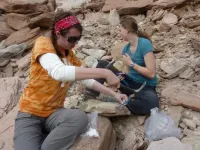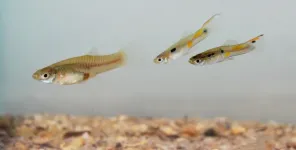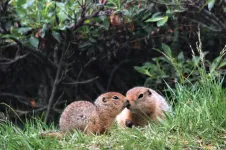(Press-News.org) Families are complicated. For members of the Alligatoridae family, which includes living caimans and alligators - this is especially true. They are closely related, but because of their similarity, their identification can even stump paleontologists.
But after the recent discovery of a partial skull, the caimans of years past may provide some clarity into the complex, and incomplete, history of its relatives and their movements across time and space.
Michelle Stocker, an assistant professor of vertebrate paleontology in Virginia Tech's Department of Geosciences in the College of Science; Chris Kirk, of the University of Texas at Austin; and Christopher Brochu, of the University of Iowa, have identified a 42-million-year-old partial skull that may have belonged to one of the last prehistoric caimans to roam the United States.
"Any fossil that we find has unique information that it contributes to understanding the history of life," said Stocker, who is an affiliated faculty member of the Fralin Life Sciences Institute and the Global Change Center. "From what we have, we are able to understand a little bit more about the evolutionary history of caimans and the alligatorid group, which includes alligators and caimans."
Their findings were published in PeerJ, an open access peer-reviewed scientific mega journal covering research in the biological and medical sciences.
The fossil was discovered in 2010 at Midwestern State University's Dalquest Desert Research Site, which includes extensive exposures of the Devil's Graveyard Formation, a geologic formation in the Trans-Pecos volcanic field of West Texas.
The Devil's Graveyard Formation preserves fossils from the latter portion of the Eocene epoch, a period of time covering 15 million years of prehistory.
In 2011, Stocker and the team returned to the site to collect a key bone that remained in the hard sandstone block that once encapsulated the caiman skull.
"The Devil's Graveyard Formation provides a unique window into the evolution of North American vertebrates during the middle and late Eocene," said Kirk. "There are a host of extinct species that are only known from the Devil's Graveyard, including several primates, rodents, lizards, and now this new fossil caiman."
What they discovered was a partial skull. At the time of the discovery, paleontologists were convinced that the skull came from a closer relative to alligators than to caimans.
"When you are at the early diversification of groups, their features aren't as differentiable," said Stocker. "It was harder to tell if this is more closely related to caimans or to alligators because those two are really closely related already. And the differences between them are subtle, especially early in their evolutionary history."
The skull's braincase was a key component in the identification of the fossil. The braincase encases and protects the brain from injury. Since no two species have the same braincase, finding one can provide some much needed information for paleontologists.
After further investigation into this fossil's braincase, Stocker and the team were able to determine that this was, without a doubt, a caiman.
The caiman was deemed to be 42 million years old by using a combination of investigative techniques, including radiometric dating, biochronology, and biostratigraphy, where paleontologists use the relative order of the fossilized animals to find out how old the rocks are.
With the age of the fossil and its location in mind, paleontologists are able to add to an ever-growing story about a large biogeographic range contraction, or a climate-related extirpation, that occurred millions of years ago.
Roughly 56 million years ago, the planet was experiencing temperatures so hot and methane levels so high that no polar ice caps could form. For large cool-blooded reptiles like alligators and caimans, it was their time to thrive and soak up the sun. In fact, the conditions were so favorable that these early reptiles roamed as far north as northern Canada.
"The presence of a fossil caiman in the Devil's Graveyard, about 1,200 kilometers north of where caimans are found today, really says something about how different the climate of West Texas was in the middle Eocene", said Kirk.
But one epoch later, in the Oligocene, the entire world was experiencing cooler temperatures, forcing many species that require warm and humid conditions into more restricted geographic ranges.
Caiman populations, in particular, are now only found in South and Central America. Although, a small number of caimans have been found outside of this range and are thought to be invasive species.
"This caiman seems out of place," said Brochu."Caimans today are a South American radiation, and data from modern forms, including DNA, would suggest a very simple single origin from a North American ancestor. This new form, along with some older North American fossil caimans, suggests a far more complex early history with multiple crossings of the seaway that separated North and South America until fairly recently."
There is even more to know about caiman history. Since the specimen was an incomplete skull, and far from a complete skeleton, paleontologists still have some knowledge gaps to fill about their relationships.
"If we can find another individual, we will get a better sense of its relationships, and it might be able to say something about what variation could be present in this taxon, or how they grow, or where else they might be found," said Stocker. "This is a one-and-done kind of fossil right now. Hopefully there are more out there."
The fossil will be housed at the Texas Vertebrate Paleontology Collections at the University of Texas at Austin where it will be preserved and maintained in perpetuity.
There is more research to be done on other fossils that have been retrieved from Central and South American specimens, as well. Those fossils, in particular, are critical for understanding the early southern record of caiman history and clearing up the morphological and chronologic gaps that currently exist in the caiman fossil record.
In the end, all that lies on the horizon is to do more fieldwork, collect more fossils, and conduct more study.
Without museums, this identification couldn't have been possible. When paleontologists find new fossils, they must travel to museums, where they compare the new fossils with other specimens that have been collected.
Stocker maintains that the preservation and maintenance that museums do is just one reason that they need to be supported.
"Museums are important for science and for everybody who wants to understand our shared evolutionary history," said Stocker. "And collaboration is the way that science moves forward."
INFORMATION:
Researchers from University of Stavanger, University of Melbourne, and University of Wisconsin-Madison published a new paper in the Journal of Marketing that examines how major projects undertaken by temporary organizations can be better managed so that cost overruns are minimized.
The study forthcoming in the Journal of Marketing is titled "Mobilizing the Temporary Organization: The Governance Roles of Selection and Pricing" and is authored by Elham Ghazimatin, Erik Mooi, and Jan Heide.
When consumers return to the skies again, they may do so in Boeing's 787 Dreamliner. But the project, or "temporary organization," created to make this plane ...
Just like humans trying to stick to New Year's resolutions, guppies have varying levels of self-control, a new study shows.
Researchers from the University of Exeter and Ghent University studying the behaviours of Trinidadian guppies tested "inhibitory control" (suppressing unhelpful impulses or urges).
The tiny fish first learned how to swim into a cylinder to get food - then a cover was removed to make the cylinder transparent.
Inhibitory control was measured by whether a guppy resisted the urge to swim directly towards the food - bumping into the cylinder - or still swam around, ...
Researchers have developed a DNA test to quickly identify secondary infections in COVID-19 patients, who have double the risk of developing pneumonia while on ventilation than non-COVID-19 patients.
For patients with the most severe forms of COVID-19, mechanical ventilation is often the only way to keep them alive, as doctors use anti-inflammatory therapies to treat their inflamed lungs. However, these patients are susceptible to further infections from bacteria and fungi that they may acquire while in hospital - so called 'ventilator-associated pneumonia'.
Now, a team of scientists ...
Former director of public health Professor John Ashton has said that scientific scepticism may be reinforced by the UK's rush to approve COVID vaccines for public use and the apparent political desire to be the first out of the blocks in contrast to our European neighbours.
Writing in the Journal of the Royal Society of Medicine, Prof Ashton says that to risk the trust of the public for the sake of a couple of weeks propaganda advantage could prove to be unforgivable should vaccine uptake fall below that required for the ubiquitous 'herd immunity' as a result of giving oxygen to the sceptics.
"In this age of scientific rationality, superstition and anti-science still run deep," he writes. "When an overwhelming majority of the public welcomes the arrival of ...
BOSTON - Studies with a popular laboratory model, the nematode Caenorhabditis elegans, have revealed a possible therapeutic avenue for a rare but deadly condition in which children are born without the ability to make molybdenum cofactor (Moco) on their own.
Though little known, Moco is essential for life and so far it has proven extremely difficult to stably isolate this compound in the laboratory, preventing its use as a therapeutic supplement. This new work, which appears in Genes & Development, reveals that nematodes genetically engineered to be Moco-deficient can take up Moco that is attached to several types of proteins. This suggests that such protein-Moco complexes could be used as a treatment ...
In a normal year, biologists Daniel Janzen and Winnie Hallwachs spend about six months in Costa Rica, where they conduct research and pursue conservation efforts in Área de Conservación Guanacaste (ACG), a World Heritage Site in the northwest that encompasses, a network of parks and preserves they helped establish in the 1980s and that has grown to more than 400,000 acres, including marine, dry forest, cloud forest, and rain forest environments.
In 2020 that is where the married couple was when the COVID-19 pandemic took hold of the world, and compelled them to extend their stay in the virus-free forest until the fall, when they felt safe enough to travel back to their other home in Philadelphia.
"With modern laptops and internet, we could watch the world go ...
Anthropologist Caleb Everett and former student Sihan Chen used a novel data analysis of thousands of languages, in addition to studying a unique subset of celebrities, to reveal how a soft food diet--contrasted with the diet of hunter-gatherers--is restructuring dentition and changing how people speak.
Their findings, published in Scientific Reports, counter the longstanding belief within the field that maintains that languages are susceptible to the same pressures and so are essentially immune to external factors.
"Our results represent the most compelling evidence to date that languages are very much affected by external ...
When the Thomas Fire raged through Ventura and Santa Barbara counties in December 2017, Danielle Touma, at the time an earth science researcher at Stanford, was stunned by its severity. Burning for more than a month and scorching 440 square miles, the fire was then considered the worst in California's history.
Six months later the Mendocino Complex Fire upended that record and took out 717 square miles over three months. Record-setting California wildfires have since been the norm, with five of the top 10 occurring in 2020 alone.
The disturbing trend sparked some questions for Touma, who is now a postdoctoral researcher at UC Santa Barbara's Bren School for Environmental ...
DARIEN, IL - Editors of the Journal of Clinical Sleep Medicine have identified some of the most significant articles in the publication's history, publishing new commentaries on them in a special 15th anniversary collection. The 15 commentaries from associate editors and members of the journal's editorial board describe the impact of the selected articles both at the time of their publication and today.
"The collection highlights some of the most influential publications in clinical sleep research over the past 15 years," JCSM Editor-in-Chief Dr. Nany Collop said. "These studies underscore the remarkable ...
By feeding arctic ground squirrels special diets, researchers have found that omega-3 fatty acids, common in flax seed and fish oil, help keep the animals warmer in deep hibernation.
A University of Alaska Fairbanks-led study fed ground squirrels either a diet high in omega-3s or a normal laboratory diet, and measured how the animals hibernated afterward. Researchers found that the omega-3 diet helped the animals hibernate a little warmer than normal without negatively affecting hibernation. The omega-3 diets also increased the amount of a heat-producing fat, called brown adipose tissue, the animals pack on.
The discovery could add more understanding ...


